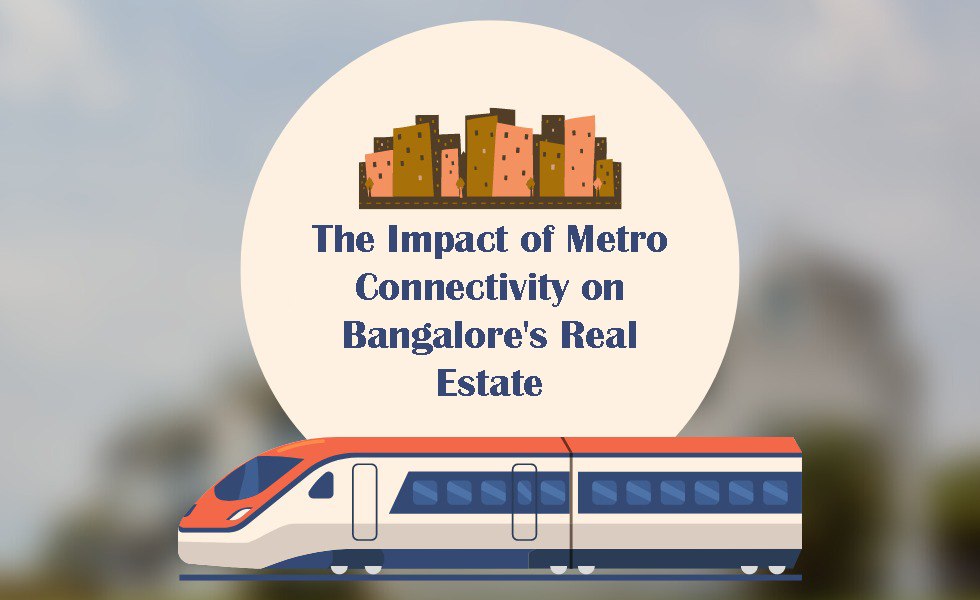The Impact of Metro Connectivity on Bangalore's Real Estate
Read latest blogs and articles from Housystan

The Information mentioned here was last updated on:
20/1/2026The Impact of Metro Connectivity on Bangalore's Real Estate
Bangalore, often called the "Silicon Valley of India," is a bustling metropolis infamous for its traffic woes and dynamic real estate market. One of the city's most transformative developments in recent years has been the expansion of its metro system. Metro connectivity has significantly impacted Bangalore's real estate market by making commuting easier and enhancing property values across the city. Let's explore how metro connectivity is reshaping the landscape of Bangalore's real estate market.
The Growth of Metro Connectivity in Bangalore
- Verified Tenants/Buyers
- Unlimited Property Listing
- Zero subscription/charges fee
Bangalore's metro network, known as Namma Metro, currently spans over 50 kilometers and serves thousands of commuters daily. It was inaugurated in 2011 and has continued to expand, with plans for a comprehensive network covering over 100 kilometers in the coming years. The metro system has been a game-changer for Bangalore, promising to alleviate traffic congestion and reduce travel time drastically.
How Metro Connectivity Enhances Real Estate Demand
1. Increased Accessibility
- Convenience: One of the primary reasons metro connectivity boosts real estate is sheer convenience. Properties near metro stations often become highly sought after because they provide easy access to the rest of the city.
- Reduced Commute Time: For many Bangaloreans, commuting to work can take hours. The metro significantly cuts travel time, making areas previously considered remote accessible.
2. Boost in Property Values
- Higher ROI: Properties near metro stations tend to appreciate faster. Research indicates that real estate close to metro lines typically commands higher prices, as buyers are willing to pay a premium for convenience.
- Development Opportunities: Areas surrounding metro lines often witness rapid commercial and residential development, leading to increased property values.
3. Emerging Real Estate Hotspots
- New Growth Areas: Several areas in Bangalore have transformed into real estate hotspots thanks to upcoming metro lines. Examples include Whitefield, Yeshwanthpur, and Electronic City. These neighborhoods are witnessing a surge in demand due to improved connectivity.
- Balanced Development: By providing accessibility to less developed areas, the metro encourages balanced development throughout the city.
Impact on Different Real Estate Segments
1. Residential Real Estate
- Apartments and Gated Communities: Proximity to metro stations makes residential projects attractive to young professionals and families. Developers often highlight metro accessibility as a key selling point.
- Rental Markets: Metro connectivity bolsters rental demand as individuals prefer living near transit lines, ensuring steady rental income for property owners.
2. Commercial Real Estate
- Office Spaces: Besides residential properties, commercial spaces also benefit. Businesses seek office locations that are easily accessible via public transport, especially for employees.
- Retail Outlets: Areas around metro stations attract large footfalls, benefiting retail stores and leading to a rise in commercial property value.
Challenges and Considerations
1. Infrastructure Strain
- Urban Congestion: While the metro reduces road traffic, there is concern about overcrowding around stations, amplifying urban congestion.
- Environmental Concerns: Construction of metro lines may pose environmental challenges, requiring thoughtful urban planning to mitigate adverse impacts.
2. Inclusive Development
- Affordable Housing: With property prices rising near metro stations, ensuring affordable housing remains a concern. Urban planners and developers must work together to balance development and affordable housing.
- Socio-Economic Divides: Without proactive measures, increased property values might lead to gentrification, displacing low-income populations from metro-accessible areas.
Future Prospects for Bangalore's Metro and Real Estate
The ongoing expansion of Bangalore's metro network is set to further transform the city's real estate dynamics. Upcoming phases aim to link key industrial and residential zones, making properties along these corridors attractive investment opportunities.
- Integrated Townships: The future may see the emergence of integrated townships around new metro lines, offering work, living, and recreational facilities within accessible distances.
- Sustainability Efforts: As Bangalore expands its metro, sustainable development focusing on green spaces and community areas will be integral to avoiding negative urban sprawl effects.
In conclusion, the extension of Bangalore's metro network is dramatically influencing its real estate sector. Improved accessibility, enhanced property values, and the rise of new residential and commercial hubs underscore the metro's transformative power. While challenges exist, the metro's role in shaping a more connected, efficient, and prosperous Bangalore is undeniable, laying the groundwork for continued urban development.